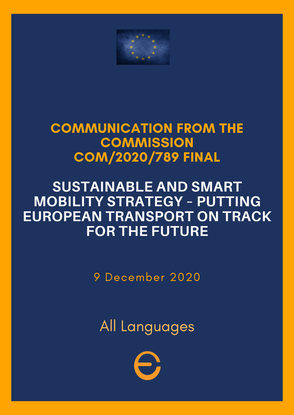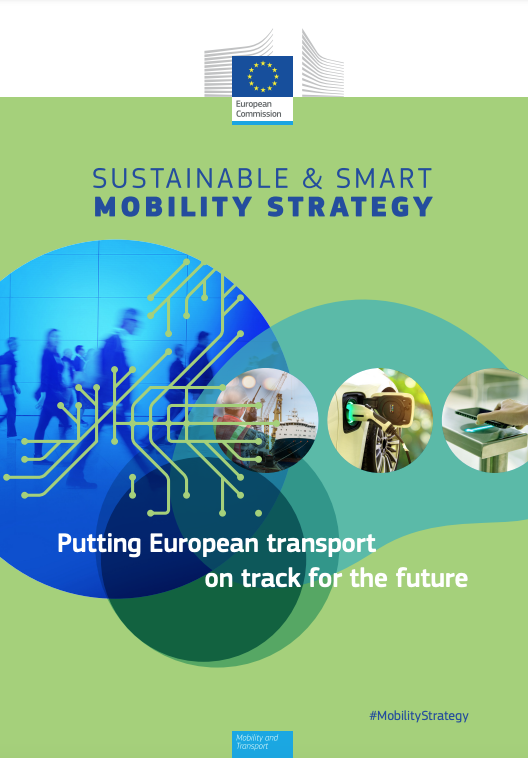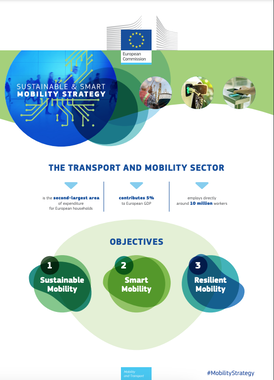|
Brussels, |
|
Transport and Mobility Strategy
MOBILITY & TRANSPORT
 Click to read
Click to read
The European Commission's Sustainable and Smart Mobility Strategy is a forward-thinking blueprint aiming to revolutionize the EU's transport systems into entities that are not only greener and more digital but also resilient. This strategy is encapsulated in an Action Plan comprising 82 initiatives set to be rolled out over the next 4 years. The ambition is bold: a 90% cut in emissions by 2050, with a focus on ensuring transport that is sustainable, smart, competitive, safe, accessible, and affordable.
Key milestones of this strategy are set to redefine mobility across the EU. By 2030, the EU envisions at least 30 million zero-emission cars on its roads, a doubling of high-speed rail traffic, and the realization of carbon-neutral urban travel for distances under 500 km. The horizon extends further to 2050, with predictions that nearly all cars, vans, buses, and new heavy-duty vehicles will be zero-emission. In the same vein, rail freight traffic is expected to double, and a fully operational multimodal Trans-European Transport Network (TEN-T) will epitomize sustainable and smart transport with high-speed connectivity.
The strategy is not just about reaching environmental targets; it's about ushering in an era of sustainable practices, innovative digitalization, and resilience, especially in the wake of the COVID-19 pandemic. It seeks to transform European transport into a system that is not only environmentally friendly but also efficient, technologically advanced, and responsive to the needs of a modern, interconnected Europe.
In line with this vision, the European Commission has recently adopted a series of proposals to reinforce this strategic framework, particularly focusing on improving the experience of passengers and travelers by strengthening their rights. These new rules are informed by the lessons learned from recent crises, including the COVID-19 pandemic and the bankruptcy of major travel groups. They aim to clarify and enhance rules on reimbursements, ensure smoother multimodal journeys, and provide direct support and real-time information to passengers, especially those with disabilities or reduced mobility.
The holistic approach of these proposals aligns seamlessly with the broader objectives of the Sustainable and Smart Mobility Strategy. They reflect a commitment not only to transforming the infrastructure and the vehicles that traverse it but also to enhancing the quality, accessibility, and sustainability of the journeys undertaken by European citizens.
These initiatives represent the EU's steadfast commitment to creating a transport system that is not just environmentally sustainable but also resilient, inclusive, and adaptable to future challenges. By integrating these new proposals with the larger Sustainable and Smart Mobility Strategy, the EU is paving the way for a transport revolution that promises to redefine mobility, environmental stewardship, and passenger rights in the modern age.
Key milestones of this strategy are set to redefine mobility across the EU. By 2030, the EU envisions at least 30 million zero-emission cars on its roads, a doubling of high-speed rail traffic, and the realization of carbon-neutral urban travel for distances under 500 km. The horizon extends further to 2050, with predictions that nearly all cars, vans, buses, and new heavy-duty vehicles will be zero-emission. In the same vein, rail freight traffic is expected to double, and a fully operational multimodal Trans-European Transport Network (TEN-T) will epitomize sustainable and smart transport with high-speed connectivity.
The strategy is not just about reaching environmental targets; it's about ushering in an era of sustainable practices, innovative digitalization, and resilience, especially in the wake of the COVID-19 pandemic. It seeks to transform European transport into a system that is not only environmentally friendly but also efficient, technologically advanced, and responsive to the needs of a modern, interconnected Europe.
In line with this vision, the European Commission has recently adopted a series of proposals to reinforce this strategic framework, particularly focusing on improving the experience of passengers and travelers by strengthening their rights. These new rules are informed by the lessons learned from recent crises, including the COVID-19 pandemic and the bankruptcy of major travel groups. They aim to clarify and enhance rules on reimbursements, ensure smoother multimodal journeys, and provide direct support and real-time information to passengers, especially those with disabilities or reduced mobility.
The holistic approach of these proposals aligns seamlessly with the broader objectives of the Sustainable and Smart Mobility Strategy. They reflect a commitment not only to transforming the infrastructure and the vehicles that traverse it but also to enhancing the quality, accessibility, and sustainability of the journeys undertaken by European citizens.
These initiatives represent the EU's steadfast commitment to creating a transport system that is not just environmentally sustainable but also resilient, inclusive, and adaptable to future challenges. By integrating these new proposals with the larger Sustainable and Smart Mobility Strategy, the EU is paving the way for a transport revolution that promises to redefine mobility, environmental stewardship, and passenger rights in the modern age.



